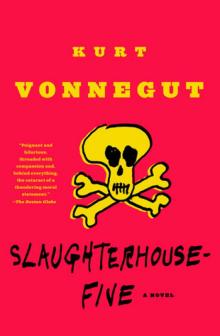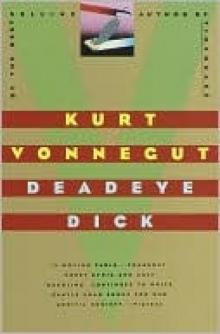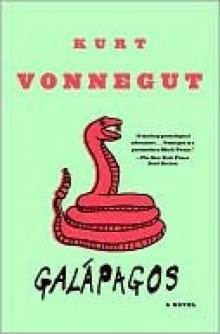- Home
- Kurt Vonnegut
Bluebeard Page 15
Bluebeard Read online
Page 15
But what sly and self-serving advice, but actually very good advice, too, I was able to give him along with flattery on this order: "You have a very strong chin. Did you know that?"
In what must surely have been the manner of powerless Armenian advisors in Turkish courts, I congratulated him on having ideas he might never have had before. An example: "You must be thinking very hard how important aerial photography is going to be, if war should come." War, of course, had come to practically everybody but the United States by then.
"Yes," he said.
"Would you turn your head the least little bit to the left?" I said. "Wonderful! That way there aren't such deep shadows in your eye sockets. I certainly don't want to lose those eyes. And could you imagine now that you are looking from a hilltop at sunset--over a valley where a battle is going to take place the next day?"
So he did that as best he could, and he couldn't talk without ruining everything. But, like a dentist, I was prefectly free to go on jabbering. "Good! Wonderful! Perfect! Don't move anything!" I said. And then I added almost absentmindedly as I laid the paint on: "Every branch of the service is claiming camouflage from the air as their specialty, even though it's obviously the business of the Engineers."
And I said a little later: "Artists are so naturally good at camouflage, I guess I'm just the first of many to be recruited by the Corps of Engineers."
Did such a sly and smarmy and Levantine seduction work? You be the judge:
The painting was unveiled at the General's retirement ceremonies. I had completed my basic training and been promoted to private first class. I was simply another soldier with an obsolescent Springfield rifle, standing in ranks before the bunting-draped scaffold which supported the painting on an easel, and from which the General spoke.
He lectured on aerial photography, and the clear mission of the Engineers to teach the other branches of the service about camouflage. He said that among the last orders he would ever give was one which called for all enlisted men with what he called "artistic experiences" to be assigned to a new camouflage unit under the command of, now get this: "Master Sergeant Rabo Karabekian. I hope I pronounced his name right."
He had, he had!
I was a master sergeant at Fort Belvoir when I read of the deaths of Dan Gregory and Fred Jones in Egypt. There was no mention of Marilee. They had died as civilians, although in uniforms, and they both got respectful obituaries, since the United States was still a neutral nation in the war. The Italians weren't our enemies yet, and the British who killed Gregory and Fred weren't yet our allies. Gregory, I remember, was bid farewell in the papers as possibly the best-known American artist in history. Fred was sent on to Judgment Day as a World War One ace, which he wasn't, and an aviation pioneer.
I, of course, wondered what had become of Marilee. She was still young and I presumed beautiful, and had a good chance of finding some man a lot richer than I was to look after her. I was certainly in no position to make her my own. Military pay was still very low even for a master sergeant. There were no Holy Grails for sale at the Post Exchange.
When my country finally went to war like everybody else, I was commissioned a lieutenant and served, if not fought, in North Africa and Sicily and England and France. I was forced to fight at last on the border of Germany, and was wounded and captured without having fired a shot. There was this white flash.
The war in Europe ended on May 8, 1945. My prison camp had not yet been captured by the Russians. I, with hundreds of other captured officers from Great Britain, from France, from Belgium, from Yugoslavia, from Russia, from Italy, which country had switched sides, from Canada and New Zealand and South Africa and Australia, from everywhere, was marched at route step out of our prison and into the still-to-be-conquered countryside. Our guards vanished one night, and we awoke the next morning on the rim of a great green valley on what is now the border between East Germany and Czechoslovakia. There may have been as many as ten thousand people below us--concentration camp survivors, slave laborers, lunatics released from asylums and ordinary criminals released from jails and prisons, captured officers and enlisted men from every Army which had fought the Germans.
What a sight! And, if that weren't enough for a person to see and then marvel about for a lifetime, listen to this: the very last remains of Hitler's armies, their uniforms in tatters but their killing machines still in working order, were also there.
Unforgettable!
26
AT THE END of my war, my country, where the only person I knew was a Chinese laundryman, paid in full for cosmetic surgery performed on the place where my eye used to be. Was I bitter? No, I was simply blank, which I came to realize was what Fred Jones used to be. Neither one of us had anything to come home to.
Who paid for my eye operation at Fort Benjamin Harrison outside Indianapolis? He was a tall, skinny fellow, tough but fair-minded, plain spoken but shrewd. No, I am not speaking of Santa Claus, whose image in shopping malls at Christmas time nowadays is largely based on a painting Dan Gregory made for Liberty magazine in 1923. No. I am speaking of my Uncle Sam.
As I've said, I married my nurse at the hospital. As I've said, we had two sons who no longer speak to me. They aren't even Karabekians anymore. They had their last names legally changed to that of their stepfather, whose name was Roy Steel.
Terry Kitchen asked me one time why, since I had so few gifts as a husband and father, I had gotten married. And I heard myself say: "That's the way the postwar movie goes."
That conversation must have taken place about five years after the war.
The two of us must have been lying on cots I had bought for the studio space we had rented above Union Square. That loft had become not only Kitchen's workplace but his home. I myself had taken to spending two or three nights a week there, as I found myself less and less beloved in the basement apartment three blocks away, where my wife and children lived.
What did my wife have to complain about? I had quit my job as a salesman of life insurance for Connecticut General. I was intoxicated most of the time not only by alcohol but by the creation of huge fields of a single color of Sateen Dura-Luxe. I had rented a potato barn and made a down payment on a house out here, which was then a wilderness.
And in the midst of that domestic nightmare there arrived a registered letter from Italy, a country I had never seen. It asked me to come to Florence, all expenses paid for one, to testify in a lawsuit there about two paintings, a Giotto and a Masaccio, which had been taken by American soldiers from a German general in Paris. They had been turned over to my platoon of art experts to be catalogued and shipped to a warehouse in Le Havre, where they were to be crated and stored. The general had evidently stolen them from a private house while retreating north through Florence.
The crating in Le Havre was done by Italian prisoners of war, who had done that sort of work in civilian life. One of them evidently found a way to ship both paintings to his wife in Rome, where he kept them hidden, except to show to close friends after the war. The rightful owners were suing to recover them.
So I went over there alone, and I got my name in the papers for accounting for the trip the paintings made from Paris to Le Havre.
But I had a secret, which I have never told anybody before: "Once an illustrator, always an illustrator!" I couldn't help seeing stories in my own compositions of strips of colored tape applied to vast, featureless fields of Sateen Dura-Luxe. This idea came into my head uninvited, like a nitwit tune for a singing commercial, and would not get out again; each strip of tape was the soul at the core of some sort of person or lower animal.
So whenever I stuck on a piece of tape, the voice of the illustrator in me who would not die would say, for example, "The orange tape is the soul of an Arctic explorer, separated from his companions, and the white one is the soul of a charging polar bear."
This secret fantasy, moreover, infected and continues to infect my way of seeing scenes in real life. If I watch two people talking on a street co
rner, I see not only their flesh and clothes, but narrow, vertical bands of color inside them--not so much like tape, actually, but more like low-intensity neon tubes.
When I got back to my hotel at about noon on my last day in Florence, there was a note for me in my pigeonhole. As far as I knew, I had no friends in all of Italy. The note on expensive paper with a noble crest at the top said this:
There can't be all that many Rabo Karabekians in the world. If you're the wrong one, come on over anyway. I'm mad for Armenians. Isn't everybody? You can rub your feet on my carpets and make sparks. Sound like fun? Down with modern art! Wear something green.
And it was signed, Marilee, Countess Portomaggiore (the coal miner's daughter).
Wow!
27
I TELEPHONED HER at once from the hotel. She asked if I could come to tea in an hour! I said I sure could! My heart was beating like mad!
She was only four blocks away--in a palazzo designed for Innocenzo "the Invisible" de Medici by Leon Battista Alberti in the middle of the fifteenth century. It was a cruciform structure whose four wings abutted on a domed rotunda twelve meters in diameter and in whose walls were half embedded eighteen Corinthian columns four and a half meters high. Above the capitals of the columns was a clerestory, a wall pierced with thirty-six windows. Above this was the dome--on whose underside was an epiphany, God Almighty and Jesus and the Virgin Mary and angels looking down through clouds, painted by Paolo Uccello. The terrazzo floor, its designer unknown, but almost surely a Venetian, was decorated with the backs of peasants planting and harvesting and cooking and baking and making wine and so on.
The incomparable Rabo Karabekian is not here demonstrating his connoisseurship nor his Armenian gift for total recall--nor his fluency with the metric system, for that matter. All the information above comes from a brand new book published by Alfred A. Knopf, Incorporated, called Private Art Treasures of Tuscany, with text and photographs by a South Korean political exile named Kim Bum Suk. According to the preface, it was originally Kim Bum Suk's doctoral thesis for a degree in the history of architecture from Massachusetts Institute of Technology. He managed to examine and photograph the interiors of many opulent private homes in and around Florence which few scholars had ever seen, and whose art treasures had never before been photographed by an outsider or noted in any public catalogue.
Among these hitherto impenetrable private spaces was, hey presto, the palazzo of Innocenzo "the Invisible" de Medici, which I myself penetrated thirty-seven years ago.
The palazzo and its contents, uninterruptedly private property for five and a half centuries now, remains private property, following the death of my friend, Marilee, Contessa Portomaggiore, who was the person who, according to the book, gave Kim Bum Suk and his camera and his metric measuring instruments the run of the place. Ownership, upon Marilee's death two years ago, passed on to her late husband's nearest male blood relative, a second cousin, an automobile dealer in Milan, who sold it at once to an Egyptian man of mystery, believed to be an arms dealer. His name? Hold on to your hats; his name is Leo Mamigonian]
Small World!
He is the son of Vartan Mamigonian, the man who diverted my parents from Paris to San Ignacio, and who cost me an eye, among other things. How could I ever forgive Vartan Mamigonian?
Leo Mamigonian bought all the contents of the palazzo, too, and so must own Marilee's collection of Abstract Expressionist paintings, which was the best in Europe, and second in the world only to mine.
What is it about Armenians that they always do so well? There should be an investigation.
How did I come to possess Kim Bum Suk's invaluable doctoral thesis at precisely the moment I must write about my reunion with Marilee in 1950? We have here another coincidence, which superstitious persons would no doubt take seriously.
Two days ago, the widow Berman, made vivacious and supranaturally alert by God only knows what postwar pharmaceutical miracles, entered the bookstore in East Hampton, and heard, by her own account, one book out of hundreds calling out to her. It said that I would like it. So she bought it for me.
She had no way of knowing that I was on the brink of writing about Florence. Nobody did. She gave me the book without herself examining the contents, and so did not know that my old girlfriend's palazzo was therein described.
One would soon go mad if one took such coincidences too seriously. One might be led to suspect that there were all sorts of things going on in the Universe which he or she did not thoroughly understand.
Dr. Kim or Dr. Bum or Dr. Suk, whichever is the family name, if any, has cleared up two questions I had about the rotunda when I myself was privileged to see it. The first puzzle was how the dome was filled with natural light in the daytime. It turns out that there were mirrors on the sills of the clerestory windows--and there were still more mirrors on the roofs outside to capture sunbeams and deflect them upward into the dome.
The second puzzle was this: why were the vast rectangles between the encircling columns at ground level blank? How could any art patron have left them bare? When I saw them, they were painted the palest rose-orange, not unlike the Sateen Dura-Luxe shade yclept "Maui Eventide."
Dr. Kim or Dr. Bum or Dr. Suk explains that lightly clad pagan gods and goddesses used to cavort in these spaces, and that they were lost forever. They had not been merely concealed under coats of paint. They had been scraped off the walls during the exile of the Medicis from Florence from 1494, two years after the discovery of this hemisphere by white people, until 1531. The murals were destroyed by the insistence of the Dominican monk Girolamo Savonarola, who wished to dispel every trace of paganism, which he felt had poisoned the city during the reign of the Medicis.
The murals were the work of Giovanni Vitelli, about whom almost nothing else is known, except that he was said to have been born in Pisa. One may assume that he was the Rabo Karabekian of his time, and that Christian fundamentalism was his Sateen Dura-Luxe.
Kim Bum Suk, incidentally, was thrown out of his native South Korea for forming a union of university students which demanded improvements in the curricula.
Girolamo Savonarola, incidentally, was hanged and burned in the piazza in front of what had been the Palazzo of Innocenzo "the Invisible" de Medici in 1494.
I sure love history. I don't know why Celeste and her friends aren't more interested.
I now think of the rotunda of that palazzo, when it still had its pagan as well as its Christian images, as a Renaissance effort to make an atom bomb. It cost a great deal of money and employed many of the best minds of the time, and it compressed into a small space and in bizarre combinations the most powerful forces of the Universe as the Universe was understood in the fifteenth century.
The Universe has certainly come a long, long way since then.
As for Innocenzo "the Invisible" de Medici, according to Kim Bum Suk: he was a banker, which I choose to translate as "loan shark and extortionist" or "gangster," in the parlance of the present day. He was simultaneously the richest and least public member of his family. No portrait of him was ever made, save for a bust done of him when a child by the sculptor Lorenzo Ghiberti. He himself smashed that bust when he was fifteen years old, and threw the pieces into the Arno. He attended no parties and gave none when an adult, and never traveled in the city save in a conveyance which hid him from view.
After his palazzo was completed, his most trusted henchmen and even the highest dignitaries, including two of his own cousins who were Popes, never saw him save in the rotunda. They were obliged to stand at the edge of it, while he alone occupied the middle--wearing a shapeless monk's robe and a death's-head mask.
He drowned while in exile in Venice. This was long before the invention of water wings.
When Marilee told me on the telephone to come over to her palazzo right away, the tone of her voice, coupled with her confession that there were no men in her life just then, seemed guarantees to me that in no more than two hours, probably, I would be getting more o
f the greatest loving I had ever had--and not a callow youth this time, but as a war hero, roue, and seasoned cosmopolite!
I in turn warned her that I had lost an eye in battle, and so would be wearing an eye patch, and that I was married, yes, but that the marriage was on the rocks.
I am afraid that I said, too, in making light of my years as a warrior, that I had spent most of my time "... combing pussy out of my hair." This meant that women had made themselves available to me in great numbers. This odd locution was a variant of a metaphor which made a lot more sense: a person who had been shelled a great deal might say that he had been combing tree bursts out of his hair.
So I arrived at the appointed hour in a twanging state of vanity and concupiscence. I was led by a female servant down a long, straight corridor to the edge of the rotunda. All the Contessa Portomaggiore's servants were females--even the porters and gardeners. The one who let me in, I remember, struck me as mannish and unfriendly--and then downright military when she told me to stop just inside the rotunda.
At the center, clad from neck to floor in the deepest black mourning for her husband, Count Bruno--there stood Marilee.
She wasn't wearing a death's-head mask, but her face was so pale and in the dim light so close to the color of her flaxen hair that her head might have been carved from a single piece of old ivory.
I was aghast.
Her voice was imperious and scornful. "So, my faithless little Armenian protege," she said, "we meet again."
28
"THOUGHT YOU WERE going to get laid again, I'll bet," she said. Her words echoed whisperingly in the dome--as though they were being discussed up there by the Divinities.
"Surprise, surprise," she said, "we're not even going to shake hands today."
I wagged my head in unhappy wonderment. "Why are you so mad at me?" I asked.

 Slaughterhouse-Five
Slaughterhouse-Five Bagombo Snuff Box: Uncollected Short Fiction
Bagombo Snuff Box: Uncollected Short Fiction God Bless You, Dr. Kevorkian
God Bless You, Dr. Kevorkian Breakfast of Champions
Breakfast of Champions While Mortals Sleep: Unpublished Short Fiction
While Mortals Sleep: Unpublished Short Fiction Slapstick or Lonesome No More!
Slapstick or Lonesome No More! Cat's Cradle
Cat's Cradle The Sirens of Titan
The Sirens of Titan A Man Without a Country
A Man Without a Country Look at the Birdie: Unpublished Short Fiction
Look at the Birdie: Unpublished Short Fiction Bluebeard
Bluebeard Hocus Pocus
Hocus Pocus The Big Trip Up Yonder
The Big Trip Up Yonder Palm Sunday: An Autobiographical Collage
Palm Sunday: An Autobiographical Collage Jailbird
Jailbird Happy Birthday, Wanda June
Happy Birthday, Wanda June Welcome to the Monkey House
Welcome to the Monkey House Player Piano
Player Piano Fates Worse Than Death: An Autobiographical Collage
Fates Worse Than Death: An Autobiographical Collage Love, Kurt
Love, Kurt Timequake
Timequake God Bless You, Mr. Rosewater
God Bless You, Mr. Rosewater 2 B R 0 2 B
2 B R 0 2 B The Eden Express: A Memoir of Insanity
The Eden Express: A Memoir of Insanity Mother Night
Mother Night Deadeye Dick
Deadeye Dick Galápagos
Galápagos Palm Sunday
Palm Sunday We Are What We Pretend to Be
We Are What We Pretend to Be Look at the Birdie
Look at the Birdie Basic Training
Basic Training Armageddon in Retrospect
Armageddon in Retrospect Basic Training (Kindle Single)
Basic Training (Kindle Single) If This Isn't Nice, What Is?
If This Isn't Nice, What Is? Bagombo Snuff Box
Bagombo Snuff Box The Petrified Ants
The Petrified Ants Cat's Cradle: A Novel
Cat's Cradle: A Novel Fates Worse Than Death: An Autobiographical Collage (Kurt Vonnegut Series)
Fates Worse Than Death: An Autobiographical Collage (Kurt Vonnegut Series)